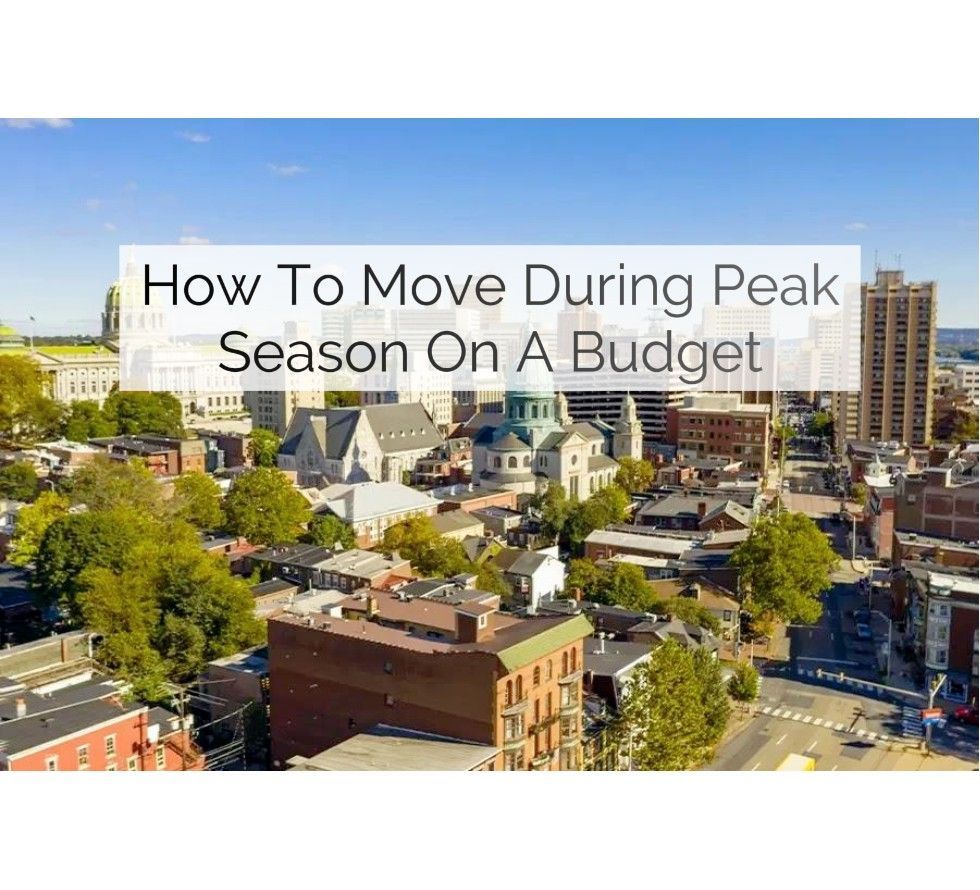By Jadin Ogden
•
October 31, 2025
We know that planning a move is both exciting and overwhelming, especially when you're trying to decide not just whether to move to the New Cumberland area, but exactly where in this region you should call home. You've probably noticed that when you search for homes "near New Cumberland," you're getting results from Camp Hill, Lemoyne, Mechanicsburg, and several other communities. That's not a mistake—it's because New Cumberland sits at the heart of Pennsylvania's West Shore, surrounded by distinct suburban communities that each offer their own character and advantages. Here's the reality: New Cumberland itself is just 1.4 square miles. It's a charming borough with a genuine downtown and riverfront access, but its compact size means that many people who want to live "in the New Cumberland area" end up choosing one of the surrounding suburbs instead. And that's perfectly fine—in fact, it might be exactly what you need. As your local moving partner at Making Moves PA , we've helped families relocate throughout the entire West Shore region. We've moved young professionals into Camp Hill apartments five minutes from New Cumberland's downtown, helped families settle into Mechanicsburg's spacious neighborhoods, and assisted retirees in finding their perfect spot in Lemoyne's quiet streets. We know these suburbs intimately—not just their zip codes, but their personalities. In this guide, we'll walk you through each suburb near New Cumberland, giving you the honest details you need to make the right choice. We'll cover what makes each community unique, who tends to thrive there, and how they compare to living in New Cumberland proper. By the end, you'll understand whether New Cumberland itself is your best fit, or whether one of these surrounding suburbs better matches your priorities. Understanding New Cumberland's Suburban Context Before we dive into specific suburbs of New Cumberland, it helps to understand the geography. New Cumberland sits directly across the Susquehanna River from Harrisburg, Pennsylvania's capital. It's bordered by the river to the west, Route 11/15 (Carlisle Pike) to the east, and surrounded by Lower Allen Township and East Pennsboro Township . The communities we consider "New Cumberland suburbs" are those within a 10-minute drive—close enough that you're still functionally living in the same area, with similar commute times to Harrisburg, access to the same schools (in many cases), and participation in the same regional amenities. These include Camp Hill, Lemoyne, Mechanicsburg, Wormleysburg, and Enola. Each maintains its own municipal identity, with separate borough halls, police departments, and community characters. Yet they're all interconnected, sharing school districts, shopping corridors, and that West Shore identity that distinguishes this side of the river from Harrisburg proper or the East Shore communities. Camp Hill: New Cumberland's Upscale Neighbor What Defines Camp Hill Camp Hill sits immediately south and east of New Cumberland, separated primarily by Route 11/15 and some township boundaries. If New Cumberland is the small-town borough with historic charm, Camp Hill is its slightly more polished, decidedly more upscale neighbor. The downtown area along Market Street in Camp Hill feels like a more developed version of New Cumberland's Bridge Street. You'll find Cornerstone Coffeehouse & Cafe (a local favorite that draws from both communities), Pizza Grille , The Radler , and Market Cross Pub & Brewery . The shopping is more extensive, with Camp Hill Shopping Center anchored by Giant Food Stores and surrounded by specialty retailers like Salon Vivace and Stoney Creek Roasters Coffee Roasters . Housing in Camp Hill skews toward higher price points than New Cumberland. The tree-lined neighborhoods feature substantial single-family homes, many dating from the 1920s through 1960s, with meticulous landscaping and larger lots. You'll find Colonial-style homes, brick Tudors, and classic Pennsylvania stone houses, typically ranging from 2,000 to 3,500 square feet. Who Thrives in Camp Hill Camp Hill attracts professionals, established families, and anyone seeking a more upscale suburban experience while staying close to Harrisburg. The Camp Hill School District (which includes parts of the West Shore area) consistently ranks among the top in the region, making this particularly popular with families who prioritize education. Cedar Cliff High School serves the area and regularly produces high graduation rates and strong college placement numbers. You'll meet doctors who work at UPMC Harrisburg or Penn State Health , attorneys who practice in Harrisburg, and business executives who commute to offices along the Route 581 corridor. The demographic skews slightly older and more affluent than New Cumberland—think established homeowners rather than first-time buyers. The lifestyle here emphasizes walkability (at least in the downtown area), community events at Willow Park and Memorial Park , and a certain civic pride. Camp Hill maintains its reputation through strict property maintenance standards and active community organizations. Comparing Camp Hill to New Cumberland Camp Hill offers more extensive shopping and dining than New Cumberland, higher-performing schools, and generally larger homes with more land. The trade-off? Higher property values, higher taxes, and perhaps less of that authentic small-town feel. If you're looking for luxury neighborhoods in New Cumberland but finding inventory limited, Camp Hill's established sections often provide similar upscale character with more options. For families specifically comparing these areas, our best family neighborhoods in New Cumberland guide provides school comparisons and family-specific amenities, though Camp Hill often comes out ahead on purely educational metrics. Commute times to Harrisburg are nearly identical—both communities are about 10 minutes from downtown via the Market Street Bridge . The practical difference comes down to character and cost: New Cumberland feels more intimate and affordable; Camp Hill feels more polished and premium. Lemoyne: The Quiet Riverside Borough What Defines Lemoyne Lemoyne sits directly north of New Cumberland, also hugging the Susquehanna River. It's smaller and quieter than Camp Hill, but offers similar proximity to Harrisburg with a distinctly more residential, low-key character. The borough lacks the commercial density of Camp Hill or even New Cumberland's Bridge Street corridor. Instead, you'll find essential services scattered along Hummel Avenue and Herman Avenue —a Rite Aid , Family Dollar , and local establishments like Dockside Willies (which technically straddles the New Cumberland-Lemoyne border). For more extensive shopping and dining, residents typically head to nearby communities. Housing in Lemoyne presents excellent value. You'll find modest single-family homes, twins, and some townhomes, mostly dating from the 1920s through 1970s, at price points generally 10-15% lower than comparable Camp Hill properties and roughly similar to New Cumberland. Lots tend to be smaller, streets are narrow, and the overall aesthetic is functional rather than fancy. Who Thrives in Lemoyne Lemoyne attracts people who want West Shore living without West Shore prices. It's popular with young families buying their first home, retirees downsizing from larger properties in Camp Hill or Mechanicsburg, and professionals who prioritize commute convenience over prestigious addresses. The community is genuinely diverse in age and income—you'll find everyone from teachers and nurses to middle managers and small business owners. What unites residents is a preference for peace and quiet, and an appreciation for practical value over status. Schools are through the West Shore School District , the same district that serves New Cumberland. Lemoyne Elementary School sits right in the borough, making the walk to school easy for younger children. The district feeds into Cedar Cliff High School , providing solid educational options without the premium price tag of Camp Hill schools. Comparing Lemoyne to New Cumberland Lemoyne and New Cumberland share remarkable similarities—both are small boroughs along the river, both have historic sections with character, both offer the same school district. The key differences are subtle: New Cumberland has a more developed downtown with better walkability to shops and restaurants, while Lemoyne is more purely residential. For those exploring the most affordable areas in New Cumberland and finding even those stretch the budget, Lemoyne often provides similar housing at lower price points. You're sacrificing some of New Cumberland's downtown walkability, but gaining the same river access and similar commute times. Both communities also face similar flood considerations in their riverside sections. Federal Emergency Management Agency (FEMA) flood maps apply to both, and prospective buyers should carefully evaluate flood history and insurance requirements for properties near Lemoyne Waterfront Park or along the river roads. Mechanicsburg: Space, Schools, and Suburban Comfort What Defines Mechanicsburg Mechanicsburg sits about 10 minutes west of New Cumberland, and it's a completely different experience. This is a proper suburban town—larger (9 square miles), more sprawling, with extensive commercial development, multiple shopping centers, and that classic American suburb character. The downtown area along Main Street has been revitalized in recent years, now featuring Cornerstone Coffeehouse (yes, another location), Café Bruges , Brewhouse Grille & Brewery , The Piazza Sorrento , and Market Cross Pub . Shopping is abundant, with Giant Food Stores , Walmart Supercenter , Target , Weis Markets , and countless smaller retailers throughout the borough. Housing options are extensive and varied. Historic neighborhoods near downtown feature Victorian and Colonial-style homes similar to New Cumberland's character. Post-war subdivisions offer ranches and split-levels. Newer developments on the outskirts provide modern colonials and contemporary designs with open floor plans, attached garages, and suburban yards. Who Thrives in Mechanicsburg Mechanicsburg attracts families seeking space, good schools, and suburban convenience. The Mechanicsburg Area School District consistently ranks well, with Mechanicsburg Area Senior High School offering strong academics, extensive extracurriculars, and competitive athletics. You'll find a broad demographic mix—young families in starter homes, established professionals in executive neighborhoods, military families stationed at Carlisle Barracks or Naval Support Activity Mechanicsburg , and retirees in age-restricted communities. The common thread is prioritizing practical suburban living: good schools, easy shopping, manageable commutes, and room to breathe. The community has that classic suburban social structure—youth sports leagues are huge here, with Cumberland Valley Rail Trail and numerous parks like Soldiers & Sailors Memorial Park and Willow Mill Park providing recreation space. The Mechanicsburg Museum Association and various community organizations create active civic engagement. Comparing Mechanicsburg to New Cumberland This is really a question of lifestyle preference. Mechanicsburg offers more space—larger homes, bigger yards, more shopping options, more restaurants. New Cumberland offers more character and better walkability. Mechanicsburg feels definitively suburban; New Cumberland feels like a small town. For families specifically weighing these options, our best family neighborhoods in New Cumberland analysis often leads to Mechanicsburg when space and schools are the top priorities, while New Cumberland wins when walkability and character matter more. Property values are generally comparable, though you typically get more square footage in Mechanicsburg for the same money. Taxes vary by specific location but are broadly similar across both communities. The commute to Harrisburg is slightly longer from Mechanicsburg—figure 15-20 minutes depending on which section of Mechanicsburg you're in, versus 10 minutes from New Cumberland. For professionals working in Mechanicsburg itself or at Naval Support Activity Mechanicsburg , obviously Mechanicsburg makes more sense. Wormleysburg: The Overlooked Riverfront Gem What Defines Wormleysburg Wormleysburg is probably the least known of New Cumberland's neighboring suburbs, but it deserves serious consideration. This tiny borough (population around 2,900) sits along the Susquehanna River north of both New Cumberland and Lemoyne, directly across from Harrisburg's City Island. The defining feature is location, location, location. You're literally a 5-minute drive from downtown Harrisburg via the Harvey Taylor Bridge —making this one of the shortest commutes to Pennsylvania's capital. The Riverfront Park provides stunning river views and direct access to walking and biking trails. Housing stock is predominantly older—think 1920s through 1950s construction—with modest single-family homes, twins, and some rowhomes. Properties tend to be smaller, streets are tight, and parking can be challenging. But the riverside location and quick Harrisburg access make up for limited square footage. Commercial development is minimal. Residents head to Lemoyne, Camp Hill, or across the river to Harrisburg for most shopping and dining needs. Wormleysburg Borough Hall and Wormleysburg Fire Department provide local services, but this is primarily a residential community. Who Thrives in Wormleysburg Wormleysburg attracts a specific type of resident: people who work in Harrisburg and want the shortest possible commute while maintaining a distinct suburban address. You'll find state government employees, healthcare workers at Harrisburg hospitals, and professionals whose offices sit in downtown Harrisburg. The community also appeals to those who truly value river access and don't need extensive shopping or entertainment in their immediate neighborhood. If you're content driving 5-10 minutes for restaurants and shopping but want to kayak from your neighborhood or run along riverside trails every morning, Wormleysburg delivers. Schools are through the West Shore School District , same as New Cumberland and Lemoyne, with students attending Lemoyne Elementary School and eventually Cedar Cliff High School . Comparing Wormleysburg to New Cumberland These communities share remarkable similarities—small borough size, river location, historic housing stock, same school district. The key difference is commercial walkability: New Cumberland has a functional downtown you can walk to; Wormleysburg doesn't. Wormleysburg wins decisively on Harrisburg commute time—you're 5 minutes versus New Cumberland's 10 minutes. For someone working in downtown Harrisburg who values every extra minute of sleep or family time, that difference matters. Property values in Wormleysburg tend to run slightly lower than New Cumberland, partly because of smaller homes and limited commercial amenities. For those exploring the most affordable areas in New Cumberland and remaining flexible about location, Wormleysburg often provides the best value in the immediate region while maintaining river access and quick Harrisburg proximity. Enola: East Pennsboro's Suburban Hub What Defines Enola Enola isn't technically a borough—it's an unincorporated community within East Pennsboro Township , sitting about 10 minutes north/northwest of New Cumberland. But it functions as a distinct suburban area with its own identity, centered around the Summerdale and Enola zip codes. This is spread-out, car-dependent suburban living. You'll find a mix of post-war ranches, split-levels, and more recent colonial-style developments, all with generous yards and suburban street patterns. Shopping centers dot Route 11/15 and Route 944 , including Giant Food Stores , various fast-food chains, and service businesses. The area lacks a traditional downtown but compensates with space and affordability. Lots are typically larger than in New Cumberland or Camp Hill, giving residents room for pools, sheds, gardens, and all the suburban accoutrements that don't fit on a 50-foot lot. East Pennsboro Township provides municipal services, with East Pennsboro Township Police Department and East Pennsboro Township Park offering community resources. Who Thrives in Enola Enola attracts families and individuals who prioritize space and value over walkability and character. You're not going to stroll to dinner in Enola—you're going to drive everywhere. But you'll have a big yard, a two-car garage, and a mortgage payment notably lower than comparable space in Camp Hill or even New Cumberland. The demographic skews toward working families, skilled tradespeople, and middle-income professionals who want suburban comfort without stretching their budget. You'll also find military families given proximity to Carlisle Barracks and Naval Support Activity Mechanicsburg . Schools are through the East Pennsboro School District , which serves this entire area. East Pennsboro Area High School provides solid academics with a suburban comprehensive high school experience—good sports programs, standard extracurriculars, and respectable graduation rates. Comparing Enola to New Cumberland This comparison comes down to priorities. If you value character, walkability, and that small-town borough feel, New Cumberland wins decisively. If you want maximum space and minimum cost, Enola delivers. For families, the best family neighborhoods in New Cumberland often compete directly with Enola subdivisions. New Cumberland offers better walking to schools and parks; Enola offers bigger yards for backyard play. Neither is objectively better—it depends on your family's lifestyle. Commute times to Harrisburg are similar—both communities are 15-20 minutes depending on exact location and traffic. For those working in Mechanicsburg or along the Route 15 corridor north toward Camp Hill, Enola often provides a shorter commute. Making Your Decision: New Cumberland or Suburbs? Now that you understand the suburbs of New Cumberland, the question becomes: should you focus your search on New Cumberland proper, or cast a wider net across these surrounding communities? Here's a framework to help you decide: Choose New Cumberland if you prioritize: Authentic small-town character with historic architecture Walkable downtown with local shops and restaurants Compact borough size where everything feels close Direct riverfront access at Soldiers and Sailors Memorial Park That "I live in a real town" identity versus generic suburbia Choose Camp Hill if you prioritize: Top-tier schools and higher property values More extensive shopping and dining options Larger homes with more land Slightly more upscale neighborhood aesthetics Willingness to pay a premium for perceived prestige Choose Lemoyne if you prioritize: Similar character to New Cumberland at lower cost Quiet, residential peace without much commercial activity Same school district as New Cumberland with lower housing prices River access without some of the flood risk in New Cumberland's most vulnerable areas Choose Mechanicsburg if you prioritize: Maximum space—bigger homes, bigger yards Extensive shopping and services all within the same town Strong suburban school district Classic American suburb lifestyle More housing inventory and variety of neighborhoods Choose Wormleysburg if you prioritize: Absolute shortest commute to downtown Harrisburg River access and trail connectivity Small-borough character similar to New Cumberland Value pricing with river location Don't need commercial walkability in your immediate neighborhood Choose Enola if you prioritize: Maximum affordability while staying in the region Largest possible yard and home for your budget Don't need or want walkability Comfortable with car-dependent suburban living Want a well-regarded school district without Camp Hill's price tag The honest truth? You're not making a mistake with any of these choices. All of these suburbs near New Cumberland offer safe, comfortable suburban living within 15 minutes of Harrisburg. They're all part of the same greater community, sharing many amenities, shopping areas, and that West Shore identity. Many of our clients at Making Moves PA start their search focused exclusively on New Cumberland and end up falling in love with a home in Camp Hill or Mechanicsburg. Others insist on New Cumberland's specific character and wouldn't consider anywhere else. Both approaches are valid—the key is understanding what you're optimizing for. We strongly recommend driving through each community during different times of day. Visit on a Saturday morning and see where people are grabbing coffee. Drive through on a weekday evening and observe the neighborhood vibe. Stop at local parks— Memorial Park in Camp Hill, Riverfront Park in Wormleysburg, Willow Mill Park in Mechanicsburg—and see which community feels right. For a comprehensive look at everything New Cumberland itself offers, check out our New Cumberland City Guide: Everything You Need to Know , which provides detailed coverage of schools, employment, recreation, and lifestyle factors. And if you're specifically interested in comparing New Cumberland's internal neighborhoods, our New Cumberland Neighborhoods breaks down the different areas within the borough itself. Once you've decided where to focus your search—whether that's New Cumberland proper or one of these excellent surrounding suburbs— Making Moves PA is ready to make your transition seamless. We know every street in every community we've discussed. We understand which areas have tight corners for moving trucks, when parking enforcement is most active, and how to efficiently navigate your move-in day. We've moved families from Brooklyn to Enola, helped young professionals relocate from Pittsburgh to Camp Hill, and assisted retirees in downsizing from Mechanicsburg to Lemoyne. We know these communities intimately, and we're here to make your move to the West Shore as smooth as possible. Welcome to New Cumberland and its surrounding suburbs. Wherever you choose to call home, we're here to help you get there. Let's get you moved in.








